Today in History: December 5
The Love of Wisdom is the Guide of Life.
Phi Beta Kappa motto
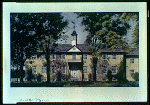
Wren Building, College of William and Mary, Williamsburg, Virginia, circa 1920-1950.
Washington as It Was, 1923-1959
On December 5, 1776, Phi Beta Kappa, America's most prestigious undergraduate honor society, was founded at the College of William and Mary in Williamsburg, Virginia. Membership in the organization is based on outstanding achievement in the liberal arts and sciences and typically limited to students in the upper tenth of their graduating class.
Organized by a group of enterprising undergraduates, Phi Beta Kappa was the nation's first Greek letter society. From 1776 to 1780, members met regularly at William and Mary to write, debate, and socialize. They also planned the organization's expansion and established the characteristics typical of American fraternities and sororities: an oath of secrecy, a code of laws, mottoes in Greek and Latin, and an elaborate initiation ritual. When the Revolutionary War forced William and Mary to close in 1780, newly-formed chapters at Harvard and Yale directed Phi Beta Kappa's growth and development.
By the time the William and Mary chapter reopened in 1851, Phi Beta Kappa was represented at colleges throughout New England. By the end of the nineteenth century, the once secretive, exclusively male social group had dropped its oath of secrecy, opened its doors to women, and transformed itself into a national honor society dedicated to fostering and recognizing excellence in the liberal arts and sciences.
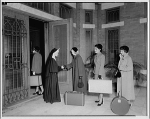
Arrival of Students at Dunbarton College, Washington, D.C.
Theodor Horydczak, photographer, circa 1920-1950.
Washington as It Was, 1923-1959
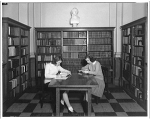
Small Alcove in Library at Trinity College, Washington, D.C.
Theodor Horydczak, photographer, circa 1920-1950.
Washington as It Was, 1923-1959
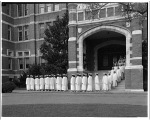
Graduation Exercises at Dunbarton College, Washington, D.C.
Theodor Horydczak, photographer, circa 1920-1950.
Washington as It Was, 1923-1959
Today, Phi Beta Kappa has over 250 chapters and over half a million living members, including six of the current Supreme Court justices and presidents George Bush and Bill Clinton. In addition to sponsoring scholarships and campus activities, Phi Beta Kappa grants book and essay awards, and publishes The American Scholar, a quarterly journal named after Ralph Waldo Emerson's 1837 Harvard lecture warning against pedantry, imitation, traditionalism, and scholarship unrelated to life.
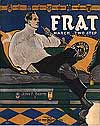
"Frat March Two-Step," John F. Barth, 1910
Historic American Sheet Music, 1850-1920.
- American Memory contains thousands of photographs of campuses and college life. Search across the American Memory Pictorial collections on college to view dormitories, sporting events, class photos and commencement ceremonies.
- Learn an old college song. Search Historic American Sheet Music on college to access ditties like "What's The Matter With Father," "College Chums Forever," and "Cap and Gown Two Step."
- See drawings and photographs of buildings which are part of William and Mary College by searching on that term in Built in America: Historic Building and Engineering, 1933-Present. See, for example, Brafferton Hall built in 1724 as the first permanent Indian school in the colonies, and the President's House, attributed to Sir Christopher Wren.
- Search the Today in History Archive on college or university to find features on historic American schools including Columbia, Howard University, and Vassar College.
The Little Magician
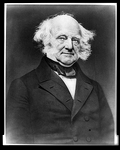
Martin Van Buren, circa 1840-1862.
Portraits of the Presidents and First Ladies, 1789-Present
Martin Van Buren, eighth president of the United States and founder of the Democratic Party, was born on December 5, 1782 in Kinderhook, New York. Just five feet six inches tall, Van Buren earned the nicknames "The Little Magician," and the "Red Fox of Kinderhook" for his legendary skill in political manipulation. Alongside his gift for politics, however, Van Buren harbored a strong sense of idealism that led him, late in his career, to oppose the westward expansion of slavery.
Van Buren rose to national fame under the wing of Andrew Jackson, who defeated President John Quincy Adams in his 1828 bid for a second term. Before coming to Washington as a senator in 1821, Van Buren crafted the powerful New York political machine known as the "Albany Regency." In 1825, he put his formidable political skills at Jackson's disposal.
Van Buren became "Old Hickory"'s strongest Northern supporter in the election of 1828, and Jackson rewarded him with an appointment as secretary of state. The election, the first in which a candidate directly appealed for the popular vote, marked a turning point in American politics and led to the emergence of the Democratic Party.
When Jackson sought a second term in 1832, Van Buren ran for vice president. On January 13, 1833, Jackson wrote a letter to his second-in-command reiterating his determination to stand firm in the Nullification Crisis of 1832-33. The letter also reveals the president's personal relationship with Van Buren, then his most trusted advisor. "I have read several letters from you which remain unanswered," he begins:
You know I am a bad correspondent at any time-lately I have been indisposed by cold, and surrounded with the nullification of the south, and the Indians in the south and west; that has occupied all of my time, not leaving me a moment for private friendship, or political discussion with a friend.President Andrew Jackson to Vice-President Van Buren, January 13, 1833.
Words and Deeds in American History
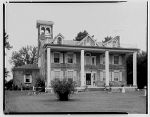
Martin Van Buren Residence, Kinderhook, New York, 1961.
Architecture and Interior Design for 20th Century America, 1935-1955
Search on Van Buren in Architecture and Interior Design for 20th Century America, 1935-1955 to find more photographs of the president's Lindenwald estate. Author Washington Irving wrote Rip Van Winkle there and is said to have gathered information for The Legend of Sleepy Hollow.
In 1837, Van Buren succeeded Jackson in the White House. Three months later, the Panic of 1837 sent the national economy into a tailspin. Van Buren's inability to alleviate the depression, along with his opposition to the annexation of Texas on grounds it would lead to expansion of slavery, led to his drubbing by Whig candidate William Henry Harrison in 1840. He retired to Lindenwald, his Kinderhook estate, where he died in 1862.
Learn more about the life and times of Martin Van Buren:
- Explore national politics in the 1820s and 1830s. Search the Words and Deeds in American History collection on Van Buren, Andrew Jackson, Henry Clay, John Calhoun or John Quincy Adams.
- Read Van Buren's position on one of the burning topics of his day—the distribution of public lands. A Century of Lawmaking reports a speech Van Buren made in the Senate in May 1826. Search on Van Buren to find this and other documents pertaining to his senatorial career.
- "A Time of Universal Prosperity and What Came of It," discusses the impact of the Panic of 1837 on Michigan citizens. This essay is part of Memorials of a Half-Century by Bela Hubbard. The complete text is available through Pioneering the Upper Midwest: 1820-1910.